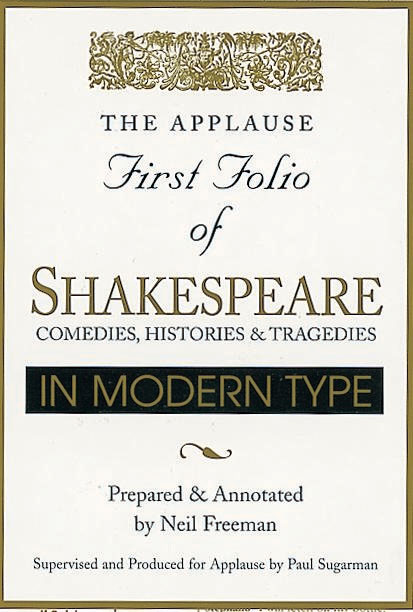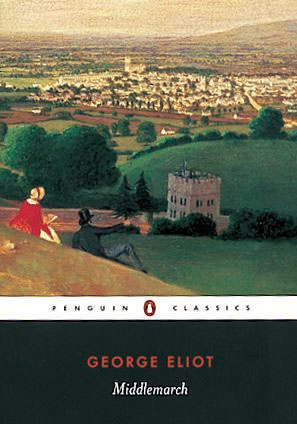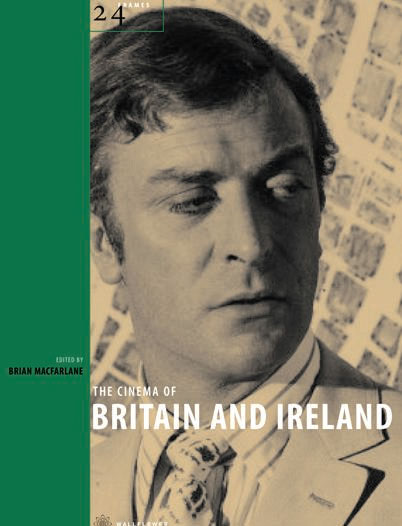
Bits of Books About Britain
[caption id="OntheBookshelf_img1" align="aligncenter" width="152"]

FEW OF US WOULD NOT LOVE to have a Shakespeare First Folio on our own bookshelves. This issue, we are honored to have Gail Kern Paster, director of the Folger Shakespeare Library in Washington, D.C., share with us just why this might be so—apart from the fact that its sale at auction could fund one’s retirement. Although George Eliot’s Middlemarch might not be quite so valuable, even in its first edition, her 1872 work is widely regarded as among the greatest English-language novels. Little wonder Eliot’s masterpiece logs in at No. 3 on our list of the 10 most British books of all time. And, if all this erudition begins to get a little weighty, perhaps it’s time to relax with a trip to the cinema. After all, a picture may not really be worth a thousand words, but it is often less work.
The Shakespeare First Folio of 1623
“Reade him, therefore; and againe, and againe,” exhort John Heminge and Henry Condell as they address “the great Variety of Readers” of the 1623 Comedies, Histories, and Tragedies of William Shakespeare, otherwise known as the First Folio.
Readers of Shakespeare have been following the advice of Shakespeare’s two fellow actors ever since—reading and rereading the plays and identifying this body of work strongly with its author (“Reade him,” say Heminge and Condell). Lovers of Shakespeare buy single-volume Shakespeare editions or weighty collected editions, but no single edition of Shakespeare commands the extraordinary veneration that book lovers reserve for the First Folio. In fact, I think it is indisputably true that the Shakespeare First Folio is the most highly prized secular book in the world. A perfect copy was sold at a Christie’s auction in 2001 to an unidentified buyer for &doller;6.1 million, and collectors will buy single sheets—sometimes to perfect an incomplete copy, sometimes merely to own a piece of the First Folio.
As 17th-century folio volumes go, the Shakespeare First Folio is not an especially rare book. More than 200 copies of an initial print run of 750 or so copies survive—79 at the Folger, 11 at the Meisei University library in Japan and the others in libraries all over the world. But the First Folio is a uniquely prized and massively studied book. In the 1950s, bibliographer Charlton K. Hinman came to the Folger to compare 55 copies, one to the others, page by page, in order to understand how the First Folio was printed—how many printers were involved in the large press job, how many compositors were actively engaged in typesetting and what the order of pages was.
By comparing these copies, Hinman was able to list the variants in the press run, to ascertain the order of the printing of pages, and to determine which of the five compositors (designated as Compositors A, B, C, D and the teenage apprentice E) typeset which combination of pages.
[caption id="OntheBookshelf_img2" align="aligncenter" width="413"]

In the course of his years of studying many copies of this one book, Hinman learned a great deal about 17th-century printing practices more generally—and bequeathed to the world of bibliographers precious knowledge about the early years of English printing. More recently, Anthony James West has compiled a worldwide census of known First Folios, tracking down and inspecting as many of them as possible in order to catalog their provenance, their sale prices over time and their individual histories as valued objects. Having already published two volumes on the First Folio—An Account of the First Folio Based on Its Sales and Prices, 1623-2000 and A New Worldwide Census of First Folios—West plans to publish two more and bring together all the knowledge about this beloved book.
But so far my account of the First Folio’s importance is largely extrinsic—focused on the value of the book as determined by its owners and by the bibliographic scholars who spend their lives studying the printed book as a historical object. The folio’s intrinsic importance, its value to the world in general, can also be objectively measured in part by reckoning the number of Shakespeare plays lost to us but for its existence. The 1623 Folio was the first of its kind—the first collected volume of plays ever published in England. Heminge and Condell decided to honor their late colleague and fellow actor—who had died in 1616—with the posthumous publication of his collected works. They secured the rights to the plays already registered—or “entered”—to other publishers, some of which had been printed earlier in quartos.
Of the 36 plays in the First Folio, 18 had never been printed before and could well have joined the large number of lost Elizabethan-Jacobean plays that we know only by their titles. These Folio-only plays include As You Like It, Julius Caesar, The Tempest, Macbeth, Measure for Measure and Twelfth Night, just for starters. I do not wish to imagine a world without any one of these plays. Even a world without Twelfth Night—which a distinguished scholar of my acquaintance calls (a bit hyperbolically) “the finest production of the human mind”—is just not thinkable.
To see these reviews and hundreds more by leading authorities, go to our new book review section at www.thehistorynet.com/reviews
[caption id="OntheBookshelf_img3" align="aligncenter" width="234"]
We owe Heminge and Condell an enormous debt of gratitude, whether we wish to credit them with a brilliant eye for a smart editorial investment, shrewd literary judgment or admirable loyalty to a beloved colleague.
GAIL KERN PASTER
Middlemarch, by George Eliot. Available in many editions, both soft and hardcover.
MIDDLEMARCH is not entirely unrivaled as the preeminent English novel of the 19th century. Charles Dickens’ later novels claim an intense imaginative grasp of the complex interrelationships of the world’s first industrial society. More than most of his contemporaries, William Makepeace Thackeray explores the implications of living in the center of an empire that stretched around the globe. And, for deployment of the romantic waywardness of the north of England, nobody can beat Emily Brontë.
Even if Middlemarch doesn’t compete in these arenas, however, no novel so intelligently, carefully and successfully explores English life in the middle years of the century. Eliot shines a raking light on the question of what it means to live as a socially responsible, autonomous person in a society marked by class and religious differences; she arrives at a typically British answer. Her characters cannot elude the daily realities of the society they were born into as Huckleberry Finn did when he headed to the frontier—though in real life many of her countrymen did just that and sought their fortunes in the empire. Few except Herman Melville’s Ishmael can spend their lives working out metaphysical problems while chasing whales—though Britain certainly had a whaling fleet. Rather, like virtually all British realist writers, Eliot insists her characters not run away, but live in their own time and country and make of it what they can.
That means reform. Middlemarch is set in the early 1830s, the beginning of an era of social and political reforms that was to last with few intermissions until way beyond 1872, when it was published. Thus, Middlemarch is a historical novel, and it is worth considering why. The marital problems encountered by Dorothea Brooke and Rosamund Vincy could have easily been set in 1872. The medical issues that exercised Lydgate did not much change. There was no alteration in the relationships between industrial centers such as Middlemarch and the agricultural areas of the surrounding countryside. So what had Eliot to gain by setting her novel in the past?
The answer is symbolic. The novel begins just after the failure of the first attempt to reform the British franchise and just before the election that brought in the 1832 parliament, which reformed voting districts and extended voting rights. Eliot frequently reminds her readers of this background, but significantly, she never explores it politically. We see no corrupted voters, no boroughs in the gift of a great landholder, little campaigning for the franchise.
[caption id="OntheBookshelf_img4" align="aligncenter" width="297"]

Her references to political reform actually emphasize the many other kinds of reform that interest her characters. Dorothea wants to devote her life to reforming the living conditions of impoverished laborers. Lydgate wants to reform medical practice by exploring the new methods he learned in Paris and Edinburgh. Sir James Chettam wants to reform farming methods, as does Caleb Garth. On a meaner level, the beautiful Rosamund is convinced that Middlemarch is beneath her. The reform she needs is an out-of-town husband who will transport her to London.
Rosamund is one of the great creations of British fiction. She excels at all the things taught to young ladies: needlework of various kinds, music and proper behavior. As the perfect pupil, she is therefore entirely confident of her correctness on every issue. But she is a monster of narcissism, focused entirely on herself. When Lydgate marries her, he ensures that he will never be free of money worries, and therefore that his medical ambitions will never be realized.
Dorothea also makes a marriage that dooms her dearest dreams. She chooses Mr. Casaubon, a clergyman committed to writing a “Key to All Mythologies.” Helping him reach his goal strikes Dorothea as worthy of her devotion. As early as their chilly honeymoon in Rome, however, she realizes that his scholarly work is pointless—out of date even before its long-delayed publication.
Casaubon blights his partner as much as Rosamund does, and like her, he is one of Eliot’s great creations: the very type of narrow learning foolishly applied. In contrast, Dorothea’s earnest efforts to give herself and her resources to some useful cause are the opposite of Rosamund’s self regard. Yet Dorothea is just as poorly educated. She has neither the practical knowledge necessary to implement her plans for cottages, nor the Latin and Greek needed to help Casaubon reach his fruitless goal.
In Dorothea and Rosamund, George Eliot questions how 19th-century middle-class Englishwomen should actually spend their time. Rosamund’s accomplishments are trivial, and lacking training, Dorothea can be no more than a benign influence on others. Then, too, what should generous-spirited young men do with themselves? Lydgate’s devotion to medical reform is valuable, but it compromises his earning ability. Fred Vincy, Rosamund’s brother, has been educated for the ministry, but knows that he is not suited to it. Fortunately his future father-in-law helps him to become an estate manager, which is just right for him. Will Ladislaw has many artistic skills but realizes it would be easy for him to flit from one to another. His answer is to devote himself to one thing—social reform—and stick with it. Eventually, Will and Dorothea end happily, though failing to achieve all they had hoped. Fred, too, lives happily. Lydgate dies at age 50, a successful doctor but a disappointed man. Rosamund gets her way—which she thinks is only right.
In other words, Middlemarch ends in a mix of sun and shade, accommodation and compromise. This acceptance of the middle way typifies much of British life and philosophy; combined with Eliot’s astute characterizations and her loving portrayal of provincial life, it establishes Middlemarch among the very best novels that have been written in Britain.
Significantly, since novels first appeared in Britain in the 18th century, women have been among their major authors. From Fanny Burney to Maria Edgeworth and Jane Austen in the 18th and early 19th centuries, through the Brontës, Elizabeth Gaskell and George Eliot (born Mary Ann Evans) in the mid-19th century, and Virginia Woolf and beyond in the 20th century, women have shaped English fiction. It is therefore no surprise that arguably the nation’s richest Victorian novel was written by a woman who, like her characters, experienced the difficulties of negotiating the claims of society.
Born in 1819 in Warwickshire, George Eliot grew up piously. Though she abandoned orthodoxy, Eliot later translated groundbreaking books of theology from German and became editor of the prestigious Westminster Review.
The love of Eliot’s life was George Henry Lewes, a talented scientist and man of letters who was unable to get a divorce. He encouraged her to write fiction and was an unfailing intellectual and moral support. Though Eliot and Lewes committed themselves permanently to each other, their unmarried state made them social pariahs among respectable Victorians. From this experience as well as from her deep learning, Mary Ann Evans produced eight novels ruminating on the trials each of us has to endure. Of these, Middlemarch is the greatest.
CLAIRE HOPLEY
The Cinema of Britain and Ireland, edited by Brian McFarlane, Wallflower Press, New York, 286 pages, softcover &doller;25.
THE BACKGROUNDS of the contributors to this essay collection attest to its value—with many of them academics, others professionals in related fields. They cover a lot of ground here.
The 24 major films critiqued—ranging from Anthony Asquith/A.V. Bramble’s Shooting Stars (1928) to Ken Loach’s Sweet Sixteen (2002)—were not all boxoffice or critical hits, yet all have much to recommend them, including skilled writing, directing, acting and camerawork, plus some strong tie-ins to history.
Knights of the Round Table, a 1954 U.S./UK production directed by Richard Thorpe, is perhaps the first of the great epics retracing key elements of the Arthurian legend. It may seem to be a strange choice for this collection. The film was financed by a major Hollywood studio, directed by an American and featured Hollywood stars Robert Taylor and Ava Gardner. It is only one example, though, of how the infrastructure of American cinema has consistently drawn on British creativity.
American producers are admittedly maligned here for their big budgets, their inability to do cross-cultural films well and their penchant for being No. 1. Yet America’s film industry has also inspired many British artists to experiment internationally and succeed. British stars like Michael Caine, Alec Guinness, Maggie Smith, Judi Dench, Peter O’Toole and Hugh Grant have done well through American connections, winning not only British awards, but also Academy Awards and honors at Cannes and elsewhere.
This book effectively surveys a range of British and Irish original films, including Victor Saville’s paradigmatic The Good Companions (1933); Robert J. Flaherty’s documentary Man of Aran (1934); Robert Hamer’s iconoclastic Pink String and Sealing Wax (1945); Ronald Neame’s patriotic Tunes of Glory (1960); Terence Davies’ poetic Distant Voices, Still Lives (1988); Neil Jordan’s Oedipal The Miracle (1991); Sally Potter’s sexually experimental Orlando (1993); and David Caffrey’s breakout Divorcing Jack (1998).
[caption id="OntheBookshelf_img5" align="aligncenter" width="402"]

Contributor Dave Rolinson indicates that an Englishman is one of the very best filmmakers these days, writing of Loach’s Sweet Sixteen (2002): “The vibrant and powerful [Sweet Sixteen] proves that, four decades after his [film-making debut], Ken Loach’s work remains passionately contemporary, sending out ‘a report from the front line’ of modern Britain.” Drugs and murder thrive, but Loach’s Spartan humanism has evolved since he began emphasizing Scottish themes in the ’90s. His interest in Northern Ireland, too, influenced BBC-TV hits like Ballykissangel, set in Ireland.
Over time, entrepreneurs like the late J. Arthur Rank and bodies such as the British Film Institute, not to mention production companies that mount the films, have benefited Britain’s film industry. Roy Baker writes: “Cinema is an art, but it is not like picking up a pencil and writing a poem. The inspiration required to guide the pencil and the camera is comparable, but cinema needs the apparatus of an industry to enable it to function.” If not the industry, Britain has the art.
DAVID MARCOU
Briefly Noted:
Victorian London: The Tale of a City 1840-1870, by Liza Picard, St. Martin’s Press, New York, hardcover &doller;29.95.
ALWAYS A FASCINATING storyteller, Liza Picard turns her witty and observant eye on the metropolis during the mid-19th century. With public executions, workhouses, cholera epidemics and milk cows in the streets, the city feels remarkably medieval. With the building of the Underground, the Great Exhibition and the coming of the railroad, the city casts itself into the modern age. There is never a dull page.
The Countryside Companion, by Malcolm Tait and Olive Tayler, Robson Books, London, hardcover &doller;15.
THIS TINY VOLUME is a gem indeed—a compendium of “pastoral pursuits, wild wonders and outdoor obsessions,” jammed full of rural wit, wisdom and customs. From the flowers of an English country garden and Morris dancing to dry stone walls and the folklore surrounding sheep, there is plenty of country dirt to dish. And if you want to skip a flat stone across the surface of the water, the optimum angle of entry is 20 degrees.





Comments